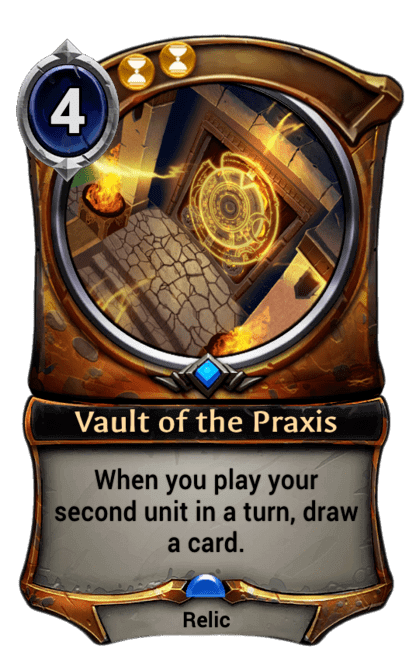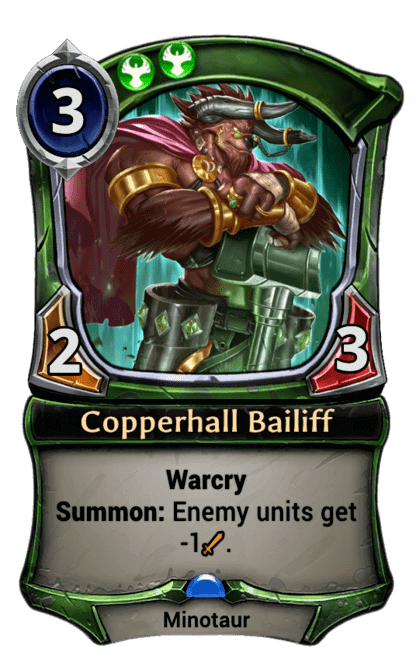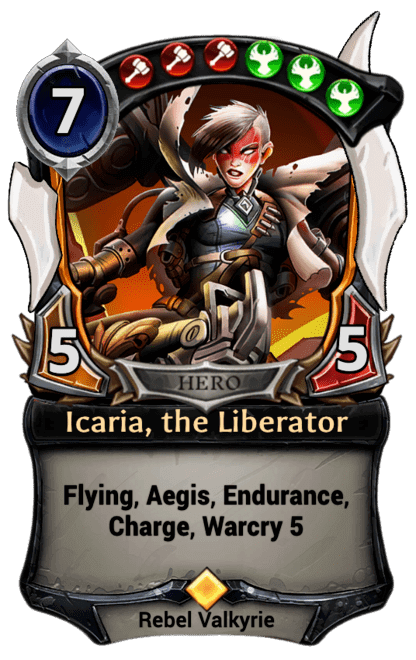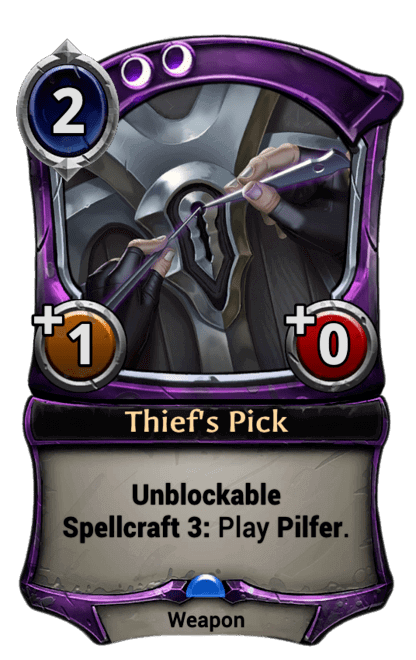

Warcry is my pick for the most fun and distinctive mechanic in Eternal. Whenever a creature with warcry attacks, the top unit of your deck gets +1/+1. That's so simple, and so compelling!
 Warcry takes advantage of two features of the digital CCG format: Persistent changes to cards and accessing information hidden from both players. The former could be implemented IRL via stickers, writing on sleeves, or even a UV coating and wet-erase marker. It would be cumbersome, but possible. You could never accomplish the latter without assigning a judge to each game. And let's be clear: It's really cool that warcry can dig into your library because it you know that bonus you earned is coming, but not when.
Warcry takes advantage of two features of the digital CCG format: Persistent changes to cards and accessing information hidden from both players. The former could be implemented IRL via stickers, writing on sleeves, or even a UV coating and wet-erase marker. It would be cumbersome, but possible. You could never accomplish the latter without assigning a judge to each game. And let's be clear: It's really cool that warcry can dig into your library because it you know that bonus you earned is coming, but not when. That's the concern with a mechanic like this, as compared with, say, Magic's Mentor. Rewarding players for attacking is a great plan because it's the fundamental mechanic that leads games to conclusion. But players respond better to concrete rewards than promises, especially when it's not clear if or when those promises will be fulfilled.
That's the concern with a mechanic like this, as compared with, say, Magic's Mentor. Rewarding players for attacking is a great plan because it's the fundamental mechanic that leads games to conclusion. But players respond better to concrete rewards than promises, especially when it's not clear if or when those promises will be fulfilled.Sometimes your next unit is 5 cards deep, so you don't see the fruits of your warcrying for a long time. That's relatively rare since warcry decks tend to want a lot of units, and imminently castable ones at that. But even when it does happen—as long as you haven't already lost the race—it's still great because now you've got one huge unit. And if that unit's got warcry, it'll probably be able to attack unhindered by your opponent's puny creatures, keeping your warcry train going. And that right there is the secret sauce.

Check out Vault of the Praxis. This card is fun because it rewards you for doing something (some) decks want to do anyhow and the reward helps you do that thing more, creating a state where you are often just barely keeping this amazing cycle of advantage. Like, you don't dare empty your hand to cast a third unit just because you've got spare power to do it, because that reduces your chances of playing two next turn and getting that sweet extra card.
 This is game design magic, folks. And it's exactly what warcry is doing. Oni Ronin is a great card, finding a role in many Ranked decks despite being a common because it's a one-drop with warcry. Being a 2/1 definitely keeps it relevant in a very competitive format, but the ability to start boosting your team's stats from turn 2 on is significant, and why players will often trade an Initiate of the Sands for it even though they really want its power acceleration. Rakano Outlaw and Crownwatch Paladin are also popular even though they cost twice as much and add no attack strength, primarily just to have more early warcriers, and secondarily because the Outlaw is hard to block and the Paladin is hard to remove.
This is game design magic, folks. And it's exactly what warcry is doing. Oni Ronin is a great card, finding a role in many Ranked decks despite being a common because it's a one-drop with warcry. Being a 2/1 definitely keeps it relevant in a very competitive format, but the ability to start boosting your team's stats from turn 2 on is significant, and why players will often trade an Initiate of the Sands for it even though they really want its power acceleration. Rakano Outlaw and Crownwatch Paladin are also popular even though they cost twice as much and add no attack strength, primarily just to have more early warcriers, and secondarily because the Outlaw is hard to block and the Paladin is hard to remove. I'm not going to list every playable warcrier going up the curve, but know that a dedicated warcry deck is usually quite aggressive and has something other aggro decks don't: The ability to finish a game with an unstoppably huge unit (who was just a normal cheap unit that got multi-boosted by your warcrying) or to roll over your opponent by curving into over-sized bodies quickly. There are also a lot of decks not focused on the warcry strategy that still run a playset just because of how much work they do. Aggro Shadow decks love Ripknife Assassin, Shadow-Justice Valkyrie decks get real value out of Battlefield Scavenger, and Copperhall Bailiff is so effective a counter to go-wide strategies, it's hard to justify excluding it from any Justice deck.
I'm not going to list every playable warcrier going up the curve, but know that a dedicated warcry deck is usually quite aggressive and has something other aggro decks don't: The ability to finish a game with an unstoppably huge unit (who was just a normal cheap unit that got multi-boosted by your warcrying) or to roll over your opponent by curving into over-sized bodies quickly. There are also a lot of decks not focused on the warcry strategy that still run a playset just because of how much work they do. Aggro Shadow decks love Ripknife Assassin, Shadow-Justice Valkyrie decks get real value out of Battlefield Scavenger, and Copperhall Bailiff is so effective a counter to go-wide strategies, it's hard to justify excluding it from any Justice deck. Like every CCG, there are also the crazy legendary versions like Kyojun, Grand Shugo, Vicious Highwayman, and the recently nerfed (by +1 cost) Icaria, the Liberator. And there are cards that bend the rules around warcry in exciting ways, like Navani, Warsinger and Sower of Dissent. Which reminds me, warcry doesn't just boost your creatures, it'll boost one of your weapons if it finds that first. Shogun's Scepter is great on-curve, but can also turn an outclassed unit into an instantly terrifying attacker when it's been boosted itself. Normally, relic weapons top out fairly small because of the danger of acting like repeatable removal, so the ability to turn your Starsteel Daisho into a 6/6 weapon is pretty scary.
Like every CCG, there are also the crazy legendary versions like Kyojun, Grand Shugo, Vicious Highwayman, and the recently nerfed (by +1 cost) Icaria, the Liberator. And there are cards that bend the rules around warcry in exciting ways, like Navani, Warsinger and Sower of Dissent. Which reminds me, warcry doesn't just boost your creatures, it'll boost one of your weapons if it finds that first. Shogun's Scepter is great on-curve, but can also turn an outclassed unit into an instantly terrifying attacker when it's been boosted itself. Normally, relic weapons top out fairly small because of the danger of acting like repeatable removal, so the ability to turn your Starsteel Daisho into a 6/6 weapon is pretty scary.
Strategies that involve spilling a bunch of threats onto the board can be weak to mass removal, and that definitely is a weakness of most warcry decks, but this is one spot where it's actually great that your reward is being applied to the field; If I attack with three warcry units the turn before your Harsh Rule, at least the next unit I get to repopulate with will be +3/+3.

There are a few counters to warcry, but they're all pretty subtle. Spitefeeder mills your opponent, hoping to snag a boosted card from the top. Fallen Oni lets you discard the top unit of the enemy deck, which is pretty reliable unless they're playing a lot of weapons. Feln Bloodcaster and Pilfer draw you the top card of your opponent's deck, so you might just nab their warcry-boosted unit or weapon. Cabal Recruiter plays the top unit of their deck, which is even better than the Oni discarding it if you can connect with it. I've never seen anyone play any of these with the intent of foiling warcry decks, but I play Thief's Pick in my infiltrator deck and Bloodcaster is a reasonable play in a control deck.
Warcry is seriously good fun because it creates an exciting reward cycle the player has to work to maintain, but does so very simply and via gameplay we want to experience anyhow.

No comments:
Post a Comment